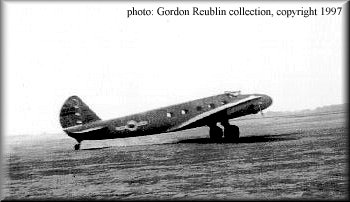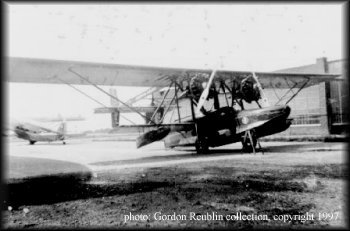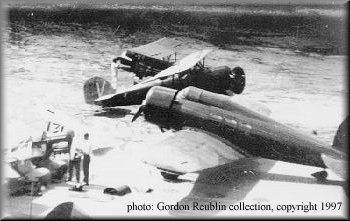

 | ||
| American Airlines Stinson Model "A" trimotor arriving Gate 3, Cleveland. The model A first went into service in 1935 with Delta Airlines. American Airlines operated 38 through 1938, all 38 were retired with a perfect passenger safety record, a major accomplishment for the 30's. Other airlines however, had less success with the "A". Delta's first production A, crashed and burned in a field in Texas following the separation of the port propeller less than a month after entering service. Three other disasters involving the model A resulted in a loss of public confidence and a brief airline career with most carriers. |  | |
 | An American Airlines Vultee V-1. The V-1 was an advanced single engined airliner that carried eight passengers. She was fitted with an 850 hp Wright Cyclone engine that allowed a 211 mph cruise speed. The Vultee was all metal, with retractable wheels. The type was first introduced by American Airlines in September of 1934. | |
| The innovative Boeing 247 taking off from Hopkins Field in Cleveland. The 247 was the first all metal streamlined monoplane airliner built in America. Powered by two 550hp Wasp engines, it was the first airliner capable of a climb out on one engine at full load. Innovations included control trim tabs, auto pilot and de-icing equipment. |  | |
 | Another American airplane, the Curtis Wright T-32 Condor.The condor sported twin 600hp Conqueror engines and offered "sleeper" service. Top speed was 159 mph. The Condor, first flown in 1929 had its origins in the B-2 bomber. The Condor accomodated 15- 18 passengers and represented the ultimate in airline comfort. A total of only 45 were built and American and Eastern Airlines were the principal users of this craft. | |
| The ubiquitous and famous Ford 4-AT-E Tri-motor. The 4-AT-E was first concieved by W.B. Stout, founder of Stout Airlines, the aircraft seated 10. Henry Ford took the concept and using a purchased Fokker F.VII trimotor, he and engineer Tom Towle rendered the basic design in metal. The metal used was corrugated and resulted in the aircraft being nicknamed the "Tin Goose". This aircraft was one that first made air travel practical and the Ford was the mainstay of the commercial airlines during the infancy of air travel. The Ford saw the first use of stewardesses (the first were registered nurses hired by United on 15 May, 1930) and in flight meals and beverages. |  | |
 | An American Airlines Sikorsky S-38 flying boat. The S-38 was popular in the late 20's-early 30's with over-water airlines. Pan American used them for their Caribbean & South America routes and American used them, as in this case, for the over the Great Lakes routes to Canada. In 1930, Sikorsky spun off a single engine version, the S-29. | |
| A Lockheed Orion on the ramp at Cleveland. The Orion was the last of Lockheed's single engine transports, seated six passengers and was powered by a 420hp P&W Wasp engine. The Orion cruised at 180-195 mph and is claimed to be the first transport capable of 200 mph. The Orion was also the first commercial aircraft with an efficient retractable undercarriage. Orions first went into service in May, 1931 with Bowen Airlines. |  | |
 | Another trimotor aircraft from the 30's, the Stinson SM-6000 trimotor. The SM-6000 was developed in 1930 to compete with the Ford trimotor. American Airlines, Chicago & Southern Airways, Century Pacific and Pennsylvania Airlines were among the airlines who operated Stinson's. This aircraft is one of Pensylvania's aircraft. Stinson trimotors were popular but had the reputation of being unsteady in rough air with resulting passenger airsickness. | |
This page updated Dec 26, I will try to get things up, running and interesting in short order.
 |  |
 |  |
 |
Email me, I'd love to hear from you rreublin@yahoo.com
This page hosted by ![]()
Get your own Free Home Page